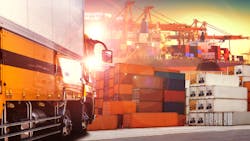Will the National Infrastructure Bill Help Relieve Supply Chain Congestion?
Download this article in PDF format.
As buyers across many different industry sectors continue to grapple with ongoing supply chain shortages, the Biden Administration is taking additional steps to help solve the problem and get the nation’s and the world’s supply chains back into more manageable shape. This month, the White House released a new report detailing the potential benefits of the bipartisan Infrastructure Investment and Jobs Act on the world’s supply chains.
“Decades of neglect and underinvestment in our infrastructure have left the links in our goods movement supply chains struggling to keep up with the rapid and persistent increase in goods movement that the pandemic has generated,” the Biden Administration points out.
Despite global disruptions due to the pandemic, it says the U.S. is moving “record numbers of goods” from its ports to shelves and homes. The Ports of Long Beach and Los Angeles, for example, which import 40% of all containerized imports into the country—are handling the most in their history, 17% more than their previous record year.
Step by Step
Thus far, the Administration has taken several steps to expedite the flow of goods including partnerships with the ports of Los Angeles and Long Beach to move to 24/7 operations—in addition to partnerships with Wal-Mart, UPS, Target and FedEx, all of which are taking similar action. It says that infrastructure deal includes numerous, fundamental changes to the nation’s ports, airports, rail and roads.
“Modern, resilient, and sustainable port, airport and freight infrastructure will help improve efficiency, reduce costs, and support U.S. competitiveness by removing bottlenecks and expediting commerce,” it says, “while reducing greenhouse gas emissions and the environmental impact on neighboring communities. The plan will strengthen supply chains by investing almost $50 billion in our ports and airports on top of expanding existing programs that support freight investment across modes.”
The legislation will also:
- Upgrade the nation’s airports and ports to strengthen supply chains, reduce costs, improve U.S. competitiveness and reduce emissions. “Our ports and waterways need repair and reimagination to address long-term disinvestment that has weakened the resilience of our supply chains,” the Administration points out in its report.
- Repair and rebuild roads and bridges critical to over-the-road trucking. Almost 70% of the goods movement volume in the U.S. is transported by trucks, while one in five miles of highways and major roads, and 45,000 bridges, are currently in “poor condition” the Administration states.
- Increase investments in freight rail and intermodal infrastructure to improve safety, efficiency and job growth for long-distance inland goods movement. Freight and intermodal rail are core to the inland movement of goods through the U.S. supply chain, delivering goods over long distances in an efficient and environmentally friendly manner.
- Make the supply chain infrastructure resilient against the impacts of climate change, cyber-attacks and extreme weather events. “Millions of Americans feel the effects of climate change each year when their roads wash out, power goes down or schools get flooded,” the Administration explains. “These effects are exacerbated when our supply chains for making and moving goods are disrupted, and those same Americans can’t access the goods and services they need on a regular basis.”
The House of Representatives passed the bipartisan Infrastructure Investment and Jobs Act in early November. The Senate passed the Act in August. The legislation is now expected to be signed into law by President Biden.
Tackling the Challenge Link by Link
In a separate report on Improving and Tracking Supply Chains Link by Link, the White House discussed how the phrase “supply chain” has become a household world during the pandemic era. It discusses how the Biden-Harris Supply Chain Disruptions Task Force is now measuring and tracking the status of the leading drivers of disruptions in the nation’s transportation and logistics supply chain, and the steps the task force is taking to ensure good continuity of supply.
For example, it says one of the most “visible and widely reported-on” indicators that the demand for goods remains abnormally high is the number of container ships waiting to dock at the Ports of Los Angeles and Long Beach. The Administration is now closely tracking the cumulative number of imported containers processed for the rest of the year and will be highlighting data twice a month.
“Preliminary data for the first half of October indicates that the ports imported nearly 380,000 loaded containers for a cumulative 8.1 million containers imported this year,” it says. “That suggests the ports remain significantly ahead of where they were at the same point in 2018 and are on pace to break new records by year’s end.”
The Biden-Harris Supply Chain Disruptions Task Force is also tracking how well the nation’s transportation and logistics supply chain is handling this increased flow. This and other efforts are being undertaken with the goal of seizing this moment to “strengthen our country’s future competitiveness by focusing longer term on building the resilience of our nation’s supply chains,” the Administration states. “That includes a goods-movement chain that is more resilient, fluid and [that] can operate at a higher velocity.”
About the Author

Bridget McCrea
Contributing Writer | Supply Chain Connect
Bridget McCrea is a freelance writer who covers business and technology for various publications.






